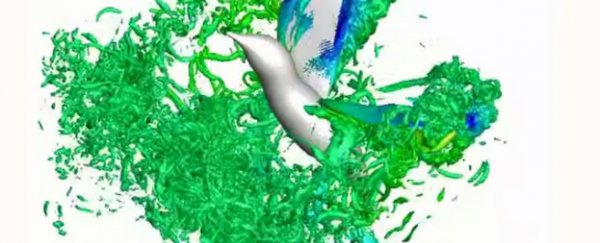Hummingbirds are famous for being nimble - they hover in the air, moving their wings so fast it looks like they're floating, before darting to their next feeding spot.
In fact, the birds are so quick, that our slow human brains have never been able to work out exactly how their wings work.
But now, mechanical engineers in the US have managed to create the most detailed simulations hummingbird flight to date, and revealed that they actually move more like insects than other birds.
And the results are seriously breathtaking, as well as fascinating, like the one below:

The team from Vanderbilt University and the University of North Carolina at Chapel Hill managed to track the wing movements of the birds by placing nine spots of non-toxic paint on a female ruby-throated hummingbird's wings as she floated near an artificial flower. They then tracked her motion using four cameras that ran at 1,000 frames per second.
Using super-computers to process this data, the engineers were the able to produce a simulation and fluid-dynamic model (below) of how the air moves around hummingbirds wings to help them stay airborne.

Their results, which have been published in the Journal of the Royal Society Interface, revealed that hummingbirds have incredible control over their wings. And unlike larger birds, the key to their flight is emphasis on the upstroke of their wing flaps - this is the same strategy that insects use, and is the key to allowing them to hover in mid-air.
When larger birds fly, they put all their effort into the downwards flap, and then flip their wings so that when they move them back up they're using pretty much no force. This generates lift and helps them stay afloat.
As Kyle Hill explains over at The Nerdist, the hummingbird model is a little more sophisticated:
To maintain a hover, a hummingbird first tilts its wing down at the wrist (yes, birds have wrists) and completes a downstroke, which creates thousands of vorticies - like thousands of whirlpools - in the air. This turbulence forms an area of low pressure beneath the wing. As surrounding air rushes in to equalise the pressure, it generates lift. But the secret of hummingbird hovering is in the upstroke. When moving its wings backwards, the hummingbird again tilts its wings but in the opposite direction - as if it was another downstroke.
The upstrokes also generate lift, allowing the birds to stay afloat.
Amazingly, the hummingbirds have managed to make their upstrokes as efficient as their downstrokes, which means they can keep up this pace for long periods of time.
The research isn't just fascinating and beautiful, but it could also help engineers try to catch up with nature when it comes to aircraft design - right now our flying vehicles use far more energy than birds and insects do. Perhaps by copying some of the little hummingbird's strategies humanity may be able to fly further than ever before.
Source: Motherboard, Nerdist, Vanderbilt University
